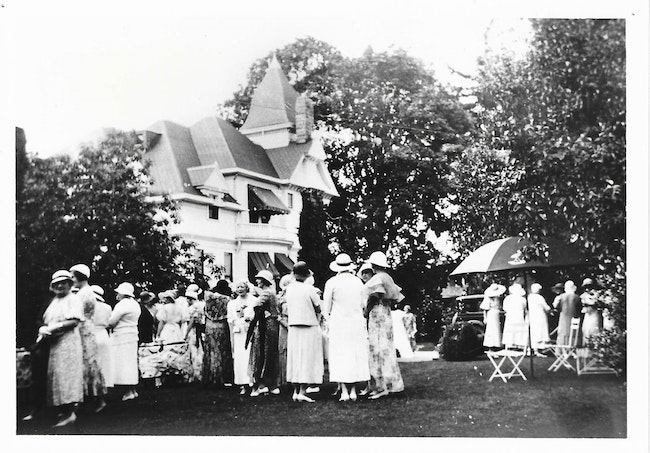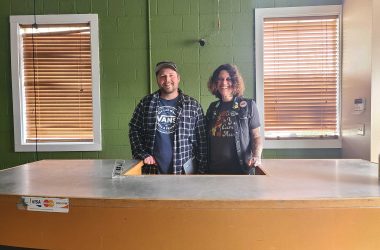 A garden party at Deepwood Gardens in 1933 (Courtesy/Deepwood Museum & Gardens)
A garden party at Deepwood Gardens in 1933 (Courtesy/Deepwood Museum & Gardens)
Editor’s note: This column is part of a regular feature from Salem Reporter to highlight local history in collaboration with area historians and historical organizations. This week, Yvonne Putze, executive director of Deepwood Museum & Gardens, explains the history of the property. If you have any feedback or would like to participate, please contact managing editor Rachel Alexander at [email protected].
Deepwood Museum & Gardens sometimes seems to be a bit of well-kept secret no matter how much we strive to make people aware of its amazing beauty. Every community has a place or two that locals go to for senior photos and wedding day images and somehow never stop to ask, “Why does this place exist- what’s the story?”
There’s so much to the story of Deepwood we could focus on it for days and never fully unravel the history that is behind the people, buildings and gardens. The stunning Victorian Queen Anne home and original Carriage House were built in 1894, but it surprises many to find out the the formal gardens on the estate were not established decades later in the 1930s.
When Luke and Lizzie Port had the home constructed, Salem had not expanded much past what would become Mission Street and the property was established more like a farm than a formal estate. To give a sense of the dramatic change that was made when the formal gardens were established, it is important to remember that what’s now the largest formal garden at Deepwood, The Great Room, was a large vegetable garden from the 1890s-1920s.
In 1924 Clifford and Alice Brown purchased the estate and almost immediately got renovations underway to the home. The family settled into the home in 1925, but life changed dramatically a few years later when Clifford drowned during a fishing expedition. Alice and their two adolescent sons continued to call the property home and by 1929 she contracted Elizabeth Lord and Edith Schryver to create the formal gardens which became such a fundamental part of the estate.
 The Great Room Garden before the gazebo was installed (Courtesy/Deepwood Museum & Gardens)
The Great Room Garden before the gazebo was installed (Courtesy/Deepwood Museum & Gardens)
So who were these women who are the names behind many of the formal parts of the gardens of Deepwood? Those of you who know Oregon’s history well may recognize the name Lord. Elizabeth Lord’s father William P. Lord was Chief Justice of Oregon’s Supreme Court at the time of Deepwood’s construction and, even more notably, the Governor of Oregon from 1895-99.
Elizabeth attended Lowthorpe School of Landscape Architecture for Women in Massachusetts which offered a rigorous three-year program emphasizing fine arts and history, as well as horticulture, garden design and construction. It was at Lowthorpe that she met Edith ‘Nina’ Schryver who had been raised in upstate New York. The two women formed a partnership to create the first female owned landscape architecture business in the Pacific Northwest. They worked on over 250 gardens including more than 25 in Salem. The legacy of consistently high-quality work is showcased by many privately owned properties and their one premier example of publicly owned garden design is Deepwood.
 Deepwood’s Great Room Garden in the early 1930s (Courtesy/Deepwood Museum & Gardens)
Deepwood’s Great Room Garden in the early 1930s (Courtesy/Deepwood Museum & Gardens)
Examples of the work of Lord & Schryver at Deepwood include the expansive Great Room with meticulously maintained boxwoods and its focal point gazebo from Portland’s 1905 Lewis and Clark Exposition. The Gazebo was brought to the garden in 1949 long after the space had been designed and planted by Lord & Schryver. For many, the Tea House Garden is understandably a favorite place to take in the peaceful beauty of this property. This is also the most complex in terms of the design. It’s an intimate English style flower garden that features a strong east-west axis. The garden was designed as a ‘moon garden’ where flowers boasting pastel colors and strong evening scents would enhance an experience in the time around dusk.
There are many special memories and stories surrounding the gardens of Deepwood. We are fortunate a determined group of people spearheaded the saving of Deepwood when it faced destruction to become the site of a corporate building. Their efforts ultimately led to the estate becoming listed on the Historic National Registry and a crown jewel in the City of Salem parks system. Those who spearheaded the saving and restoration of Deepwood ultimately formed the Friends of Deepwood which still oversees the museum home, programming, and the estate operations as they have for over five decades. They are joined in the effort with the dedication of the City of Salem Parks Department, the Deepwood Gardeners, and the Lord & Schryver Conservancy.
The Lord & Schryver Conservancy is dedicated to the ongoing preservation and interpretation of the gardens of Deepwood and offer tours of the gardens at noon on Thursdays from the spring through fall.
Yvonne Putze is the executive director of Deepwood Museum & Gardens. Learn more at DeepwoodMuseum.org, or contact her at [email protected].
JUST THE FACTS, FOR SALEM – We report on your community with care and depth, fairness and accuracy. Get local news that matters to you. Subscribe to Salem Reporter starting at $5 a month. Click I want to subscribe!









